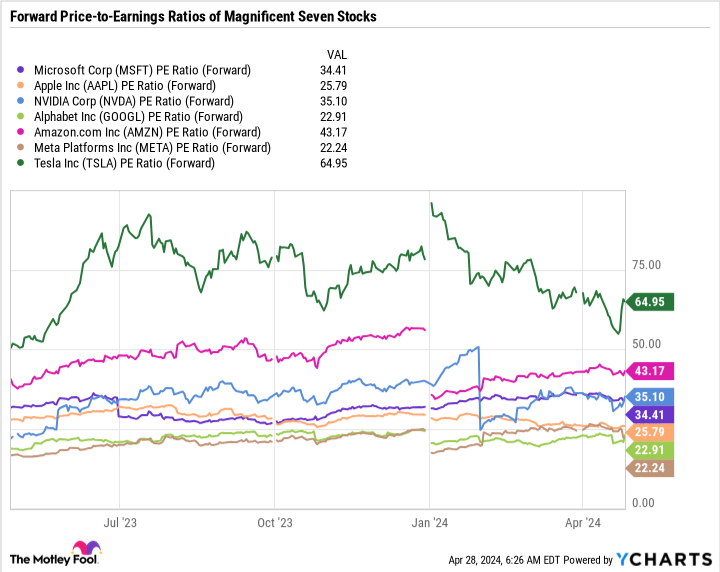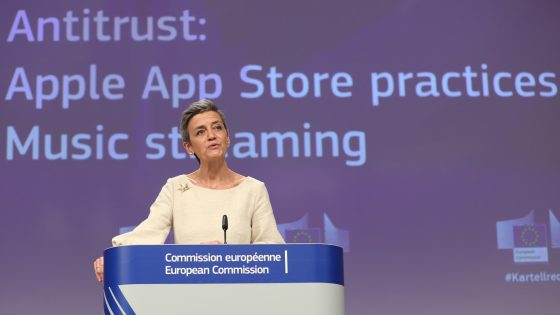The “Magnificent Seven” refers to seven mega-cap tech-oriented companies — Microsoft (NASDAQ: MSFT), Apple (NASDAQ: AAPL), Nvidia (NASDAQ: NVDA), Alphabet (NASDAQ: GOOGL) (NASDAQ: GOOG), Amazon (NASDAQ: AMZN), Meta Platforms (NASDAQ: META), and Tesla (NASDAQ: TSLA).
If you’re looking to own the whole bunch, you may be thinking about simply buying one share of each company. While that would be a beautifully simple idea, there are far better ways to go about approaching the Magnificent Seven that can be much more financially rewarding over time.
Here’s what buying one share of each Magnificent Seven stock would look like, as well as a few lessons that could benefit your portfolio for decades to come.

Pros and cons of the one-share approach
Even buying a single share of a company can be a good way to have skin in the game and feel more involved with an investment thesis. The only issue is that the arbitrary price of a stock varies wildly based on the outstanding share count, stock splits, and the market cap of a company.
I’m all for building starting positions, but buying one share of each Magnificent Seven stock is not a good approach. As you can see in the following table, the rather high price of Nvidia, Meta Platforms, and Microsoft compared to the other stocks would disproportionally overweight these companies and underweight the other four. The cost of one share of each — as of April 26 closing prices — would be $2,417.86.
|
Company |
Price Per Share |
Weighting |
|---|---|---|
|
Nvidia |
$877.35 |
36.3% |
|
Meta Platforms |
$443.29 |
18.3% |
|
Microsoft |
$406.32 |
16.8% |
|
Amazon |
$179.62 |
7.4% |
|
Alphabet |
$173.69 |
7.2% |
|
Apple |
$169.30 |
7% |
|
Tesla |
$168.29 |
7% |
Data source: Yahoo Finance prices as of market close April 26.
An alternative could be to buy a fund with high exposure to the Magnificent Seven. The Vanguard Growth ETF (NYSEMKT: VUG) has a 52.5% allocation in the Magnificent Seven, and the Vanguard Mega Cap Growth ETF (NYSEMKT: MGK) has a whopping 57% allocation.
These aren’t bad ideas, especially because the expense ratios of these massive funds are so low. However, both ETFs are market-cap-weighted, so they assign a higher allocation to Microsoft and Apple than Meta Platforms and Tesla. They are still a good choice if you want to use a higher weighting in the larger companies. But there’s an even better approach.
The value of building a clear investment thesis
Anyone can get lucky and buy a stock and have it go up. However, the best investors have guiding principles that make for a repeatable process and a higher degree of success over time.
It all starts with an investment thesis — knowing what you own and why you own it. A clear investment thesis helps you know what to look for in a quarterly earnings call or investor presentation, what not to get caught up or distracted by, and, most importantly, helps you filter out noise during extreme market euphoria or pessimism.
If you just go out and buy one share of each Magnificent Seven stock without knowing what the underlying companies really do, what Wall Street expects from them, and what’s baked into the stock price, it may lead to a poor decision down the road. For example, if Nvidia tanks by 50% and you don’t know why, will you panic-sell the stock? Or if it doubles — even for good reasons — will you sell just to cash in?
Knowing the core factors driving earnings growth is a good starting point for building an investment thesis for each company. Here’s an ultra-abridged summary to help you get started.
Microsoft: cloud infrastructure, enterprise and consumer-focused software and hardware, entertainment, media, artificial intelligence (AI).
Apple: smartphones, consumer electronics, entertainment, media, AI.
Nvidia: semiconductors, AI, data centers, gaming, graphic design, computational power.
Alphabet: internet search, cloud infrastructure, entertainment, media, advertising, consumer electronics, mobile operating systems, AI.
Amazon: cloud infrastructure, e-commerce, entertainment, AI, retail.
Meta Platforms: social media, advertising, AI, metaverse, consumer electronics.
Tesla: electric vehicles, renewable energy, energy storage, AI, robotics.
Here’s a look at each company’s valuation based on forward earnings estimates:
Again, this is just a starting point. However, knowing what a company does (generally) and what the market expects from a company can be a jumping-off point to building an investment thesis. For example, Nvidia has a whopping 73.5 price-to-earnings (P/E) ratio but a 35.1 forward P/E ratio, implying that analysts expect earnings to double in just one year. If it happens, Nvidia will look much less expensive, but if it doesn’t, the stock could look overvalued (at least in the short-term) and cause a sell-off.
Do what’s best for you
Investing is all about finding quality companies and buying them for a reasonable price, or at least a price you can justify based on the investment thesis. You could very well end up owning all of the Magnificent Seven stocks if they make sense for you.
However, a better approach could be to start with your favorite, highest-conviction idea and the one that makes the most sense for your objectives and risk tolerance. Apple could be a good pick for more value-oriented investors, while a faster-growing, more expensive name like Nvidia could be the top pick for high-risk-tolerance investors wanting to make a bold bet on AI.
Building a portfolio over time can be enjoyable and financially rewarding. But without guiding principles, you can leave yourself vulnerable to making mistakes and jeopardizing your financial goals.
Should you invest $1,000 in Nvidia right now?
Before you buy stock in Nvidia, consider this:
The Motley Fool Stock Advisor analyst team just identified what they believe are the 10 best stocks for investors to buy now… and Nvidia wasn’t one of them. The 10 stocks that made the cut could produce monster returns in the coming years.
Consider when Nvidia made this list on April 15, 2005… if you invested $1,000 at the time of our recommendation, you’d have $525,806!*
Stock Advisor provides investors with an easy-to-follow blueprint for success, including guidance on building a portfolio, regular updates from analysts, and two new stock picks each month. The Stock Advisor service has more than quadrupled the return of S&P 500 since 2002*.
*Stock Advisor returns as of April 30, 2024
Suzanne Frey, an executive at Alphabet, is a member of The Motley Fool’s board of directors. John Mackey, former CEO of Whole Foods Market, an Amazon subsidiary, is a member of The Motley Fool’s board of directors. Randi Zuckerberg, a former director of market development and spokeswoman for Facebook and sister to Meta Platforms CEO Mark Zuckerberg, is a member of The Motley Fool’s board of directors. Daniel Foelber has no position in any of the stocks mentioned. The Motley Fool has positions in and recommends Alphabet, Amazon, Apple, Meta Platforms, Microsoft, Nvidia, Tesla, and Vanguard Index Funds-Vanguard Growth ETF. The Motley Fool recommends the following options: long January 2026 $395 calls on Microsoft and short January 2026 $405 calls on Microsoft. The Motley Fool has a disclosure policy.
Should You Buy 1 Share of Each “Magnificent Seven” Stock? was originally published by The Motley Fool
Source Agencies



